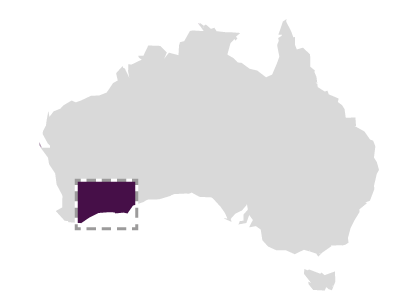Dunskey (1917/03/10)
Wilson's Inlet

Dunskey was built by David Drake at Balmain, NSW, and launched in September 1891. It had one deck, a billet head, elliptical stern and was fitted with a derrick. Originally rigged as a schooner, the Dunskey had the rig removed in 1896 or 1897. The 2-cylinder compound engine had been built by Bowen McLaughlin & Co., Paisley, Scotland. The Dunskey was purchased from its Sydney owners by William Douglas of Albany on 3 September 1897, and registered at Fremantle (No. 8/1897). Douglas subsequently sold the tug to the Armstrong and Waters partnership, also of Albany, on 3 August 1901. It was not insured.
The Dunskey was chartered to take a railway survey party to Nornalup Inlet. There were six men in the survey party; McCrosky, Bennett, Hatton, Buney, Neilson and A.C. Langler (jnr). The crew of the Dunskey comprised the captain, Alexander Armstrong (snr), the engineer, Alexander Armstrong (jnr), O.S. Parish and P.J. Ingles, firemen, and G. Keyser, deckhand. Also on board, but just as a passenger, was an old sailor, Richard Burridge. The vessel was carrying nine tons of cargo, mostly stores, survey instruments and baggage for the survey party, but also included some stores for J. Thompson, a settler at Nornalup.
The Dunskey departed Albany at 2.00 p.m. Thursday 12 March 1917, reaching West Cape Howe at 5.00 p.m. that evening and anchoring in the lee of the cape. Sailing at 2.00 a.m. the following morning the vessel arrived at Nornalup at 9.00 a.m. expecting to be met by a motor launch. The launch was not there, and so a dinghy was sent up Deep River to search for it but found nothing and so returned. About 3.00 p.m. the son of the settler Thomson sailed a small boat to the anchored Dunskey, and took two of the survey party, Burney and Neilson, to get the launch. This was expected to take some six hours.
THE LOSS
The weather at that stage was calm, but soon the wind began to increase and at 5.00 p.m. a south-westerly squall struck and the Dunskey parted its anchor cable. The vessel was immediately headed for the open sea, only to find that the shock when the anchor cable had parted had strained the bows, consequently the Dunskey was leaking quite badly. As the force of the wind increased it was found that the pumps were not coping, so everything possible, including the cargo, survey instruments, stores and personal belongings, were thrown overboard.
The Dunskey was being driven eastwards, taking in water which, because of the lack of sufficient steam, the pumps were unable to cope with. By morning there was 4 feet (1.22 m) of water in the engine-room, and 6 inches (15 cm) in the stokehold. By this time the wind had veered to the south-east, making it a headwind for the voyage to safety at Albany. It became obvious that it was impossible to continue to port so the decision was made to run the vessel onto a beach. At 8.00 a.m. the Dunskey was run aground on the bar at the entrance to Wilson Inlet, striking bottom some 50 yards offshore:
A terrific surf was running and in a few minutes the tug was battered beyond recognition. Her funnel went before those on board could leave her, and soon afterwards the deck-house followed. Every man on board had a lifebelt, and there were some lifebuoys and planking. An effort was first made to get a life-line ashore and Parish made two unsuccessful attempts in this direction before young Armstrong tried, only to fail also. Hatton then jumped overboard and was carried on the top of a wave to the beach (The Albany Advertiser, 14 March 1917: 3h).
Eventually all those on board reached shore safely, although Armstrong (snr) was at first washed out to sea, and suffered considerably from the ordeal. Both he and Langler were washed ashore in a semi-conscious condition. Harry Morgan, a local settler, was at the beach with his family and helped the survivors ashore. He also sent his son in to Denmark to bring further assistance. Within half an hour of striking the Dunskey had completely broken up.
While the survey party remained in Denmark, the crew of the Dunskey returned to Albany by train on Monday 16 March 1917.
Ship Built
Owner A. Amstrong & Waters, Albany
Master A. Amstrong
Builder David Drake of Bold Rock, Sydney
Country Built NSW
Port Built Sydney, Balmain
Port Registered Fremantle
When Built 1891/09/14
Ship Lost
Grouped Region South-Coast
Sinking Gale caused vessel to snap her cables, washed ashore and battered to bits in few minutes.
Crew 7
Deaths none
When Lost 1917/03/10
Where Lost Wilson's Inlet
Position Information No GPS
Port From Albany
Port To Nornalup Inlet
Cargo stores and instruments, manure
Ship Details
Engine 2-cylinder compound steam engine, 35 NHP
Length 22.62
Beam 4.91
TONA 34.25
TONB 50.37
Draft 2.20
Museum Reference
Official Number 101022
Unique Number 1430
Registration Number 8 of 1897
Sunk Code Wrecked and sunk
File Number 195/72
Chart Number 1034
Protected Protected Federal
Found N
Inspected N
Confidential NO